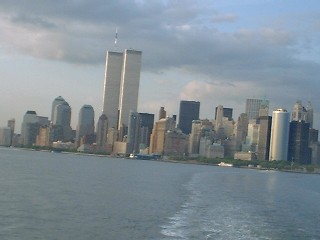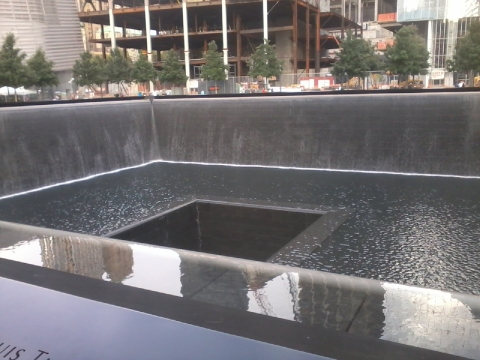
This essay, published on Tuesday, September 11, 2012, is exclusive to Notablog.
[REMEMBERING THE WORLD TRADE CENTER: 2001; 2002; 2003; 2004; 2005; 2006; 2007, 2008, 2009, 2010, 2011, 2012, 2013, 2014, 2015, 2016; 2017; 2018; 2019; 2020; 2021]
A MEMORIAL FOR THE AGES:
A PICTORIAL
By Chris Matthew Sciabarra

The Twin
Towers, from the Staten Island Ferry, May 12, 2001
This photo and all photos
below by
Chris Matthew Sciabarra
On Thursday, September 6, 2012, I traveled to the World Trade Center (WTC) site to visit the National September 11 Memorial and Museum. It is here where the Twin Towers once stood. Until they were brought down by acts of terror on September 11, 2001. I knew many of those who were killed, but I know even more survivors, some of whom I've interviewed for my annual tribute, "Remembering the World Trade Center." This year, I provide a pictorial of my Memorial visit.
The prospect of going to the Memorial (the Museum has not opened yet) was daunting; friends and relatives who had visited the site told me that it was a deeply moving experience. But nothing could have prepared me for the solemnity of the site. Upon seeing the first of the two "footprints," each marking the place where one of the Twin Towers once stood, my eyes watered. A tearful reflection, perhaps, of the waterfalls-in-perpetuity that mark each of the footprints. This was once a place of commerce and trade, of bustling, flourishing life. On a bright late summer morning in September, eleven years ago, a Tuesday much like today, it became a battleground. And a cemetery. Today, a Memorial stands. It engulfed me in a whirlwind of emotions: Moments of pain and profound sadness, punctuated still by moments of rage, that such an act could have happened in the city I still call home.
Below are a number of photos that I took; they can't possibly do justice to the site. This is a Memorial for the Ages, a reminder that we can never forget those who perished, or those who have survived, and who go on living, in the wake of unimaginable tragedy.
The first thing that one encounters on this site, known for death and destruction, is: Life. The site is teeming with life. Not simply hundreds of tourists and visitors. But trees. Over 400 white oak trees. And one more. It is known as "The Survivor Tree."

The Survivor Tree at the Memorial, 9-6-12
The
WTC Commemorative Guide tells the story:
All but one of the
trees on the Memorial are swamp white oaks. The exception is a
Callery pear tree known as the "Survivor Tree." This tree was
planted on the original World Trade Center plaza in the 1970s, and
stood at the eastern edge of the site near Church Street. After 9/11,
workers found the damaged tree, reduced to an eight-foot-tall stump,
in the wreckage at Ground Zero. The tree was nursed back to health
in a New York City park [Van
Cortlandt Park in the Bronx] and grew to be 30 feet tall, sprouting new
branches and flowering in the springtime. In March 2010, the tree was
uprooted by severe storms, but true to its name, it survived. In
December 2010, the tree returned to the WTC site. Standing just west
of the south pool, it embodies the story of survival and resilience
that is so important to the history of 9/11. Today, the tree is
supported by temporary guide wires as it takes root.
As one moves into the Memorial site, however, one becomes
aware that this is still a place of immense suffering. Each of the two
Tower footprints on the site is outlined by 30-foot waterfalls, cascading into a
reflecting pool and then into a void. It is a symbolic absence, conjoined
to a presence: the names of the dead, engraved on granite panels, around
the perimeter of each of the footprints. People's names are grouped by the
Towers in which they were last present, and among those individuals with whom
they spent their final moments.

South Tower Footprint, 9-6-12
The first "footprint" that
one sees is the place on which the South Tower of the World Trade Center once
stood (the original Two World Trade Center).

The North Tower Footprint,
9-6-12
The second "footprint"
that one encounters marks the place on which the North Tower once stood (the
original One World Trade Center).
Walking the perimeter of each footprint, looking at the
engraved granite panels,
we were able to locate only a few of the many
people we knew who were lost on September 11th.

Lisa L. Trerotola
was the sister-in-law of Lenny Trerotola, who was kind enough to grant me an
interview back in 2009.
She worked in the North Tower.
On that day, and on
this day, we remember her.
Rest in peace.
![]()
Courtney
Wainsworth Walcott was getting ready to
attend my sister's 2001 Brooklyn Tech Cheering Squad Reunion.
She talked to
him on Monday, September 10th.
They were going to make plans to meet for
lunch after the 15th.
He worked in the South Tower.
When he was lost on
9/11, my sister sent his family the jersey he had ordered for the reunion.
On that day, and on this day, we remember him.
Rest in peace.

Andre
G. Fletcher was another one of the
students my sister knew at Tech.
He and his twin brother Zack were involved
in activities and very popular.
Andre was a terrific "kid" who became a
wonderful adult.
Both he and his brother became firefighters for the FDNY.
Andre perished
in the South Tower [pdf].
On that day, and
on this day, we remember him.
Rest in peace.
![]()
I didn't know
Sylvia San Pio Resta.
She was the only Spaniard to die in the attack.
She
was 26 years old and pregnant.
She is among those honored with the phrase "and her
unborn child."
And that, in itself, must have been beyond devastating for her
family.
On that day, and
on this day, we remember them.
Rest in peace.
These are only a few of the nearly 3,000 names
of human beings who are forever memorialized at the site. It is
overwhelming. It is almost impossible to express the depth of loss that
this tragedy still evokes.
But then one looks above the
horizon of this place that was once called
The Pit. And one sees buildings.
New buildings rising to new heights. Nothing is more appropriate, in my
view---nothing is more honorable---than to restore this place with the promise
of new work, new life.



These are some of the buildings currently under
construction; on the far right and in the center panel is
the new One World
Trade Center, formerly called the "Freedom Tower," which will rise to 1,776
feet to become the tallest building in New York City and in the Western
hemisphere. These buildings are breathtaking sights to behold. But
they also stand as acts of defiance for those who will not give in to terror,
who continue to live and work in this city.
Last year, on the Tenth Anniversary of the attack, I went
with my family, to the Brooklyn Heights Promenade, as I have so many times since
that catastrophic event. We looked out across the East River, to honor the
fallen. And we try to remember---at this point, it's almost an act of
imagination---exactly where the Towers once stood.
A plaque on the Promenade commemorates the Twin Towers with a photograph, always
adorned with flowers, placed in remembrance by many who visit.

Twin Towers Commemoration, 9-11-11
From the Promenade on that Tenth Anniversary, I also photographed the Tribute in Light, two beams, symbolic of Twin Towers, that have shown up every September 11th. In cloud cover, it appears like a UFO hovering over Manhattan Island, beaming down to earth. Or perhaps a ghostly glow beamed upward toward the heavens from what was once called Ground Zero, a dual-apparition of the Twin Towers of memory, powered by the nearly 3,000 souls who lost their lives on that horrific day.

The World Trade Center Site: A Tribute in Light. At Night, 9-11-11.
 |
 |